|
|
|
Sort Order |
|
|
|
Items / Page
|
|
|
|
|
|
|
| Srl | Item |
| 1 |
ID:
126930
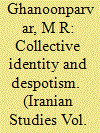

|
|
|
|
|
| Publication |
2013.
|
| Summary/Abstract |
With an overview of identity as a dominant theme in Bahram Beyzaie's artistic creations, this article examines two of his, arguably, most political plays: Chahar Sanduq (Four Boxes, 1967) and Khaterat-e Honarpisheh-ye Naqsh-e Dovvom (Memoirs of the Actor in a Supporting Role, 1981) to examine his reflections on the nature, function, and vulnerability of collective social, political, and cultural identity in authoritarian societies. Both plays illustrate that the tyrannical rulers of such societies perpetuate their dominance over their subjects through exploiting the individual's self-interests, thereby isolating him and stripping him of collective and, inevitably, individual identity. Beyzaie's allegorical and rather abstract approach in these plays contributes to conveying a less topical, culture-specific, and more universal message.
|
|
|
|
|
|
|
|
|
|
|
|
|
|
|
|
| 2 |
ID:
126933
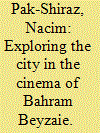

|
|
|
|
|
| Publication |
2013.
|
| Summary/Abstract |
This article explores five of Bahram Beyzaie's urban films over the last four decades to study their critique of the process of modernization and social changes that have taken place in Iran. These include The Journey (Safar, 1972), The Crow (Kalagh, 1977), Maybe Some Other Time (Shayad Vaqti Digar, 1987), Killing Mad Dogs (Sag Koshi, 2001) and When We Are All Asleep (Vaqti Hame Khabim, 2009). It examines the impact of modernization on the architecture and landscape of the city and consequently on the local community. It then studies the increasing complexity of ascertaining the real and unreal within the city. Finally, it looks at the changing values, the fears and threats within the city and the impact these have on its inhabitants, particularly women and their movement within the city.
|
|
|
|
|
|
|
|
|
|
|
|
|
|
|
|
| 3 |
ID:
126928
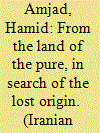

|
|
|
|
|
| Publication |
2013.
|
| Summary/Abstract |
The interview was conducted in 1997 after the publication of Beyzaie's extraordinary engagement with the legend of Siyavush in Siyavush-Khani (Siyavush Recitation). Beyzaie's experiments with Shahnameh legends are not adaptations in the strict sense of the term. This is primarily because their stories are often different from what appears in the Shahnameh, mix the narratives with other mythical sources and place them in contemporary templates with an inter-paradigmatic gaze that reflects on the meaning and the history of the present. The interview is significant in that, as it has been conducted by a leading playwright and scholar of Iranian performing arts, it enables the reader to have firsthand experience of working in Iran as a playwright and reveals some of the methods Beyzaie uses to handle his subjects.
|
|
|
|
|
|
|
|
|
|
|
|
|
|
|
|
| 4 |
ID:
126931
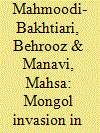

|
|
|
|
|
| Publication |
2013.
|
| Summary/Abstract |
New Historicists view history as a text through whose discontinuities and breaks the repressed and suppressed voices find ways of articulation. Likewise, a literary text, in its underlying layers, alludes to the historical conditions at the time of its production. In some cases, as in Bahram Beyzaie's works, however, the author intentionally uses the past to reread the present. He recreates history as a text in which the voices repressed in the classified history are heard. As the Mongols played an important role in the history of Iran, some of Beyzaie's works pay particular attention to them. This paper analyzes some of Beyzaie's plays and screenplays to investigate the presentation of the Mongols in his fictional worlds.
|
|
|
|
|
|
|
|
|
|
|
|
|
|
|
|
| 5 |
ID:
126929
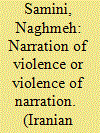

|
|
|
|
|
| Publication |
2013.
|
| Summary/Abstract |
Bahram Beyzaie is one of the most distinguished Iranian playwrights. Beginning his career in the early 1960s and still working, he is considered as a playwright who has always been looking for discovering and inventing non-classic and non-western narrative templates. To fulfill this purpose, he has made considerable use of classic Iranian literary sources, among which the One Thousand and One Nights and Ta'ziyeh texts are special cases. By analyzing Beyzaie's two plays, Hashtomin Safar-e Sandbad (The Eighth Voyage of Sinbad, 1964) and Shab-e Hezar-o Yekom (The One Thousand and First Night, 2003), which were produced within a forty-year period, this article attempts to highlight some of Beyzaie's methods of narration, particularly in relation to violence.
|
|
|
|
|
|
|
|
|
|
|
|
|
|
|
|
| 6 |
ID:
126932
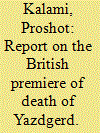

|
|
|
|
|
| Publication |
2013.
|
| Summary/Abstract |
In the spring semester of 2010, the students of the module "Non Western Performances" at Loughborough University were directed by Sudipto Chatterjee to stage the UK premiere of Bahram Beyzaie's canonical play, Death of Yazdgerd (1979). The play, which was initially supposed to be a student-led workshop as part of the module's practice, took a life of its own and turned into a full-blown production. The production consisted of all the registered students of the module who formed the cast and the crew, the main tutor and director Sudipto Chatterjee, the co-tutor and dramaturge Proshot Kalam) and the two technical tutors (Dave Hill and Mark Simpson). The present essay is an attempt to analyze the cross-cultural aspects and the practical approaches undertaken by the crew for the production of the play.
|
|
|
|
|
|
|
|
|
|
|
|
|
|
|
|
|
|
|
|
|